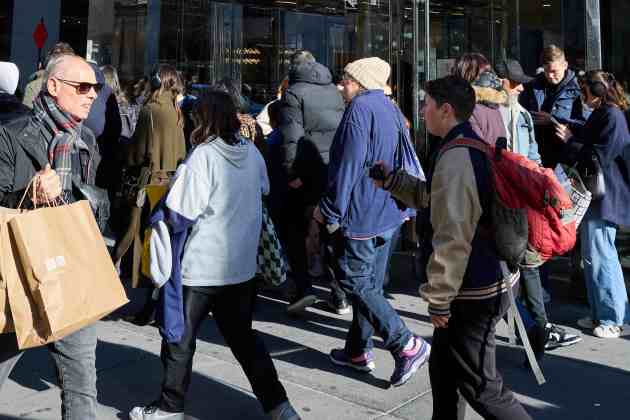The Push and Pull of Inflation in Fashion

While economists are closely watching inflation to see when it’s going to be safe enough for regulators to bring interest rates back down, fashion’s just trying not to get swamped.
January prices on all goods rose 3.1 percent from a year earlier, according to the Labor Department’s monthly reading of the Consumer Price Index on Tuesday.
More from WWD
Brands Are Spending More on Digital Ads, but Web Traffic and Conversions Are Still Declining
American Consumers Find Events Harder to Enjoy as Fees See Price Hikes
Ralph Lauren CEO Patrice Louvet on Winning with Preppy Agility
That was higher than investors expected, prompting a sell-off that sent the Dow Jones Industrial Average down 1.4 percent, or 524.63 points, to 38,272.75. Among the decliners in fashion were Allbirds Inc., down 8.2 percent to 96 cents; Hanesbrands Inc., 7 percent to $4.52; Lands End Inc., 6.6 percent to $8.50; VF Corp., 5.7 percent to $16.44; Victoria’s Secret & Co., 5.3 percent to $28.88; Birkenstock Holding, 5.1 percent to $48.13; Canada Goose Holdings Inc., 4.9 percent to $12.59, and Kohls Corp., 4.9 percent to $26.40.
Higher prices on shelter (up 6 percent), food (2.6 percent), transportation services (9.5 percent), electricity (3.8 percent) and other categories have made it harder for consumers to pay up for fashion.
Overall, including apparel, footwear and accessories, prices on fashion goods rose just 0.1 percent in January, with a 0.5 percent increase in women’s apparel prices and a 1.9 percent gain in men’s apparel.
Women’s underwear, nightwear, swimwear and accessories saw prices rise 1.9 percent while women’s outerwear fell 1.1 percent. Men’s suits, sportcoats and outerwear fell 5.3 percent while men’s shirts and sweaters gained 4.4 percent.
Mass merchants like Walmart and the next-wave fast-fashion websites like Shein are always pushing to keep prices low — striving to keep customers on a budget, who can’t spend as much on discretionary categories like apparel.
So prices at that end of the spectrum are generally falling.
John David Rainey, Walmart’s chief financial officer, told analysts in December that: “General merchandise is deflating today in the 5 percent to 6 percent range. It’s been a pretty consistent trend and it’s actually prices are getting to a point where they are the same or lower than two years ago.”
At the same time, many higher-end brands are looking to not just hold on to their post-pandemic price gains, but to keep pushing them higher.
Ralph Lauren Corp., for instance, has been at it for years now and increased average unit retail prices in its direct-to-consumer network by 9 percent in the quarter ended Dec. 30.
Price increases in the broader economy have fed those gains, which are now receding some — although the brand is continuing its effort to close the pricing and profit margin gap with pinnacle luxury.
Jane Nielsen, Ralph Lauren’s chief financial officer and chief operating officer, told analysts this month that: “We are planning a moderation in AUR growth based on a reduced need to pass like-for-like cost inflation onto the consumer. Nevertheless, we plan to continue driving positive AUR increases, as a result of our growing brand desirability, ongoing product mix elevation and favorable geographic and channel mix.”
The pandemic spurred on inflation by causing supply problems as ports and countries shut down to prevent the spread of COVID-19. U.S. inflation peaked in June 2022 at 9.1 percent.
That makes last month’s price gains of 3.1 percent look much better, although still ahead of the roughly 2 percent increase that’s seen as optimal.
Compared with December, seasonally adjusted prices inched up 0.3 percent in January — a bigger gain than the 0.2 percent rise projected by the economist opinions tallied by FactSet.
The Federal Reserve ratcheted up interest rates to bring down prices. The central bank has made remarkable progress and seems close to successful cooling off the economy without causing a recession — the ideal “soft landing” scenario.
But Jerome Powell, chair of the Fed, and his colleagues are also watching closely and being careful to not bring interest rates down too soon and risk another spike in inflation that could be even harder to tame.
Best of WWD
